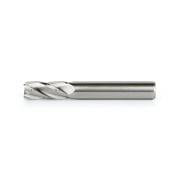HSS and high speed steel end mills
HSS and super high-speed steel cutters are essential tools in machine shops, renowned for their exceptional hardness, heat resistance and durability. These precision tools are designed for superior performance in cutting and milling operations, making them indispensable for any professional in the industry.
HSS (High-Speed Steel) cutters offer the perfect balance between wear resistance and the ability to maintain a sharp edge even at high temperatures. These characteristics make them ideal for working on materials such as steel, aluminium, brass and non-ferrous alloys. Furthermore, HSS milling cutters are available in different configurations, such as end mills, disc mills and cylindrical milling cutters, each designed for specific machining applications.
One of the most popular variants in the field of HSS milling cutters are the coated HSS milling cutters. These cutters are treated with special coatings such as titanium nitride (TiN), which further increase their wear resistance and reduce friction during cutting. TiN coating, for example, prolongs tool life and improves the surface finish of machined parts, offering a competitive advantage in high-precision milling operations.
Super high-speed steel cutters are an advanced category of cutting tools, designed to tackle the most demanding applications. These cutters are made from special alloys that include elements such as tungsten, molybdenum and cobalt, giving them greater hardness and heat resistance than standard HSS cutters. This makes them particularly suitable for high-speed machining and difficult-to-cut materials such as stainless steels and titanium alloys.
HSS and super high-speed steel cutters are essential tools for precision and efficiency in machine shops. For example, dovetail milling cutters, which are used to create precise and strong joints, are essential for manufacturing complex mechanical components. Conical milling cutters, on the other hand, are perfect for chamfering and creating conical holes, offering versatility in a wide range of applications.
Another widely used type of HSS milling cutters are cup milling cutters, mainly used for creating large diameter holes in thick materials. Due to their robust construction and ability to quickly remove large amounts of material, these cutters are particularly popular in drilling and reaming operations.
The use of HSS and super high-speed steel cutters in machine shops not only improves the quality of finished products, but also increases production efficiency. Their ability to maintain a sharp edge for longer reduces downtime due to tool changes, while their heat resistance allows them to operate at higher cutting speeds without compromising quality.











